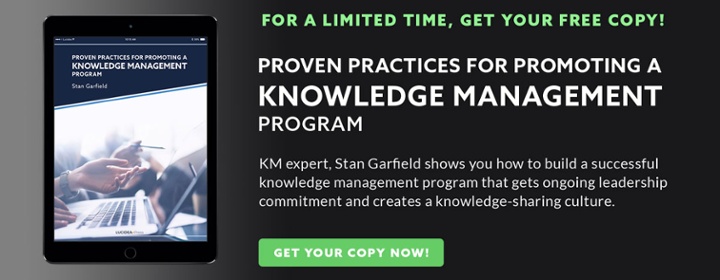 Too much focus on technology when implementing a KM program is a common problem, but you will definitely need to use software applications—so it’s important to understand them and leverage them in an optimal way. It’s imperative that you offer a truly great user experience out of the gate.
Too much focus on technology when implementing a KM program is a common problem, but you will definitely need to use software applications—so it’s important to understand them and leverage them in an optimal way. It’s imperative that you offer a truly great user experience out of the gate.
To make it easy for users to access the people, process, and technology components offered by your KM program, provide an intranet, portal site, or mobile app with obvious links to the available resources. Allow users to quickly navigate to the appropriate sites or apps based on their role, business process stage, and current requirements.
The principles of good usability should be incorporated into the user interface. Below are 10 specific suggestions for doing so. They are tailored to a home page or main mobile app, but should also be applied to other pages and apps that implement the key components of your program.
- Keep the size of the home page to a single page without the need for horizontal or vertical scrolling. The page should load quickly, be visually appealing, and be as simple as possible. Design the home page using responsive design techniques so it displays well both in the most popular web browsers and on mobile devices.
- Provide direct links to the most important sites so that multiple clicks through intermediate sites are unnecessary. Don’t make users visit multiple sites to get to the one they need.
- Remove all static information such as mission statements so that only dynamic news and useful links appear. Emphasize practical over political content.
- Avoid overwhelming users with long menus of links on the page. Provide nested drop-down menus in a horizontal navigation bar that is replicated on each page within the site. The navigation bar should collapse to a “hamburger” menu on mobile devices.
- On each page within the site or app, include standard elements in the same location. These include standard banners, footers, and navigation bars. The banner should include a search box, a people lookup box, and one or two other essential links and boxes that are used so frequently that they belong in the banner. The footer should include the date last modified, the page owner, and links for feedback and support. Standard navigation elements include a horizontal navigation bar with drop-down menus and breadcrumbs that show where you are in the web hierarchy and allow direct navigation to any higher level in the hierarchy.
- Offer faceted navigation, browsing, and searching to guide users based on the standard taxonomy.
- Use a site map to show the overall web structure and all available pages in a single view.
- Provide an index to allow users to look up any desired topic alphabetically. Include synonyms as in a thesaurus, so that regardless of which term a user chooses, they will be guided to the right place. For example, under the B section, you might include “Bulletin Boards.”
- Create a unique icon for each resource, and use it to brand the associated site. Keep all of these icons in a table, and every day feature one of them on the home page with a link to the associated site. This will serve as a reminder to users about the existence of resources, draw them in through the icon, and lead them to the site.
- Include links to the Top 10 most visited sites, most downloaded documents, and most searched-for content. These can be updated automatically or through a monthly refresh process based on the web statistics in monthly usage reports.
If you’d like to see additional suggestions, they are in my latest book, published by Lucidea Press: Proven Practices for Promoting a Knowledge Management Program, which includes more information on how best to leverage technology as a key part of your successful KM implementation, as well as additional advice and insights drawn from my career as a KM practitioner.



